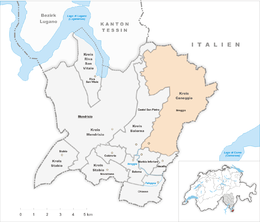Breggia
| Breggia | ||
|---|---|---|

Muggio Valley
|
||
|
||
| Coordinates: 45°52′N 9°02′E / 45.867°N 9.033°ECoordinates: 45°52′N 9°02′E / 45.867°N 9.033°E | ||
| Country | Switzerland | |
| Canton | Ticino | |
| District | Mendrisio | |
| Government | ||
| • Mayor | Sindaco | |
| Area | ||
| • Total | 25.48 km2 (9.84 sq mi) | |
| Elevation | 704 m (2,310 ft) | |
| Population (Dec 2016) | ||
| • Total | 2,059 | |
| • Density | 81/km2 (210/sq mi) | |
| SFOS number | 5269 | |
| Surrounded by | Castel San Pietro, Moltrasio (IT-CO), Schignano (IT-CO) | |
| Website |
www SFSO statistics |
|
Breggia is a municipality in the district of Mendrisio in the canton of Ticino in Switzerland. On 25 October 2009 the municipalities of Bruzella, Cabbio, Caneggio, Morbio Superiore, Muggio and Sagno merged into the municipality of Breggia.
Bruzella is first mentioned in 852 as Brusella. Cabbio is first mentioned in 1188 as Cabio. Caneggio is first mentioned in 1209 as Canegio. In 1335 it was mentioned as Canezio. Morbio Superiore is first mentioned in 1116 as Morbio de Supra. Muggio is first mentioned in 852 as Mugio. Sagno is first mentioned around 1296-99 as Sagnio.
Until 1609 it was united territorially with Monte and until 1649 it was part of the parish of Caneggio. The Church of S. Siro, is first mentioned in 1579. It was rebuilt in the 18th Century, and restored in 1973.
Traditionally, cheese production and forestery (production of timber and charcoal) were the main economic sources. This was supplemented by periodic waves of emigration. By 1985, agriculture only employed six people. At the beginning of the 21st Century, the population was largely made of retirees and commuters.
The village was mentioned in 1299 as a part of the holdings of Como Cathedral and Rusca Castle in Como. It was part of the parish of Muggio until the first half of the 17th Century, and part of the political municipality until 1673. It was part of the parish of Balerna until the early 19th Century. Until 1805, Cabbio also included the village of Casima (now part of Castel San Pietro. The parish church of S. Salvatore was first mentioned in 1579. It was rebuilt in 1780-95 and newly consecrated in 1818.
The village economy was traditionally based on forest and alpine farming, as well as emigration to other countries.
...
Wikipedia




